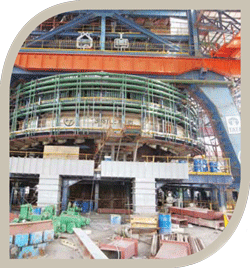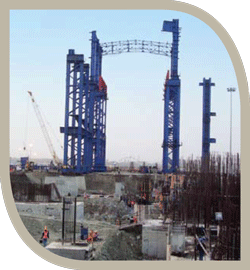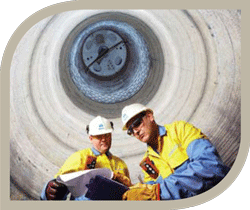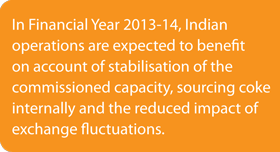|
The journey continues... The global slowdown over the last few years has impacted several industries across the world. However, the Tata Steel Group has been able to put into place measures that will enable it to take advantage of every opportunity that presents itself. By focusing on strategic expansion and leveraging on the distribution network and product differentiation, Tata Steel expects to continue on a journey of building long-term value for the stakeholders. |
||||||
|
||||||
|
Mr. H. M. Nerurkar (Managing Director, Tata Steel), Dr. Karl-Ulrich Koehler (Managing Director and Chief Executive Officer, Tata Steel Europe) and Mr. Koushik Chatterjee (Executive Director and Group Chief Financial Officer) share their views on strategy and performance in the Financial Year 2012-13. Q. How would the Tata Steel Group approach the next twelve to eighteen months given the macro economic climate? The macro environment both in India and Europe is unlikely to change very significantly in the next year or so. While India is looking for some stability in the underlying economic conditions, even if the country's GDP does not grow very sharply, one would hope that the European economic environment would start to grow green shoots and stop declining as it has, in the last couple of years. The key issue for the steel industry will be the manner in which the over capacity in China will be handled in the next couple of years. For the Tata Steel Group, the Indian operations will continue to ramp up the capacity incrementally over Financial Year 2013-14 and Financial Year 2014-15 to reach the saleable steel capacity of 9.2 mtpa (equivalent to crude steel capacity of 9.7 mtpa). We should be ready with our first phase of implementation of the Kalinganagar project by the end of Financial Year 2014-15, which effectively means, that Tata Steel will continue to enhance volumes in the next 36 to 48 months. We will continue to leverage our distribution capacity and focus marketing efforts towards new products developed, finding new customers and enhancing service standards as we have done in the past. This is the big differentiator for Tata Steel in the market place. On the other hand, the European operations continue their journey towards rationalisation of its cost base through several initiatives and pursue product differentiation to make the business fitter in the future. Our focus is on improving our supply chain capability, IT systems and the product range. This combined with right sizing is expected to provide the platform for enhanced competitiveness in the future. Q. Many steel sector investments announced in recent years, have not proceeded as planned. What are the key reasons behind this and the steps required for the smooth execution of these investment plans? How is the ramp up of the 2.9 mtpa expansion planned? 
In the not so recent past, several capacity addition plans were announced in India by domestic and global steelmakers. India was the chosen hub as it is rich in resources, had comparatively cheaper factors of production and served as a captive market with a huge growth potential. In the last two years, India too has been facing uncertainty in its economic growth due to many factors – both internal and external. Simplification of the process of land acquisition, expediting the process of environmental and forest clearances and putting in place a mechanism for mining allocations, in our view, will give the required impetus to steel investment plans and lend certainty to project execution. 
2.9 mtpa expansion at Jamshedpur, India The 2.9 mtpa brownfield expansion was perhaps the most ambitious project undertaken by the Company. To undertake the brownfield expansion in excess of 40% volume on a running plant, has its own challenges for the engineering, projects and the operations team. The teams rose to the occasion and have done a great job. This expansion covered the entire value chain of the integrated steel operations – from the expansion of the raw material facilities at the mines to the entire steel manufacturing operations, covering Raw Material Handling systems, Coke plant, Pellet plant, Steel making and finishing facilities. The ramp up of the capacity has been planned in phases. We have produced and sold about 1 million tonnes additionally in Financial Year 2012-13 and are planning to add another one million tonnes in the next financial year with the balance capacity coming in Financial Year 2014-15. The production ramp up is linked to some of the support facilities like the coke ovens which are being commissioned in phases. In the last quarter of Financial Year 2012-13, we sold almost 2.3 million tonnes which is the highest ever quarterly volume in our history, despite the market being very weak as was seen from the sub 5% annual GDP growth number for India. Q. What steps are being taken by the Indian operations to improve on its performance in Financial Year 2013-14? The Indian Steel industry witnessed an increase in crude steel production of 5.4% year-on-year, whereas the real consumption increased only by 3.3% with imports registering a sharp increase on account of lower import duties applicable to ASEAN countries. The slowdown in fixed asset investment and lacklustre automotive demand impacted margins of steelmakers adversely. In Financial Year 2013-14, Indian operations are expected to benefit on account of stabilisation of the commissioned capacity, sourcing coke internally and reduced impact of exchange fluctuations because of part liquidation of foreign currency loans. The shift to an enhanced product-mix with new cold rolling facilities being set up and the collaboration with Nippon Steel to produce high strength automotive steels is expected to aid profitability. These will be supplemented by cost reduction initiatives and penetration in new market segments like the small and medium enterprises. Q. Can you explain the market conditions in Europe and the performance of Tata Steel Europe (TSE) in Financial Year 2012-13? 
Greenfield expansion at Odisha, India The apparent steel demand in the European Union continued to deteriorate during Financial Year 2012-13 having decreased by about 9.7% in 2012. In aggregate, the steel demand in Europe is currently about 30% below pre-crisis levels, which has impacted the demand and customer buying behaviour significantly. TSE's performance in the Financial Year 2012-13 was also impacted on account of operational issues faced in rebuilding the Blast Furnace at Port Talbot, UK and undertaking of major repairs of the Blast Furnace at IJmuiden. Our performance, however, was significantly better in the 4th quarter of Financial Year 2012-13 on account of higher volumes and better spread between raw material and steel prices. Even though the market demand was relatively muted, we had a significant turnaround in our operating performance in the last quarter of the Financial Year 2012-13 compared to the previous two quarters. The rebuilding of the Blast Furnace and other management tasks and initiatives will position us on a better platform for Financial Year 2013-14 even though the market is expected to be subdued for the next 12 months. The European operations are undertaking structural improvement measures including supply chain transformation, differentiated product strategy, reduction of manufacturing costs and overheads (head count currently 25% below pre-crisis levels). These initiatives will provide the platform for enhancing the competitiveness of the European operations in the near future. Q. Can you explain the impairment charge taken by the Company in the Financial Year 2012-13? As required by the Indian Accounting Standards, Tata Steel undertook an impairment review of the consolidated financial statements for the year ended 31st March, 2013. 
Inside the shell of the new No. 4 Blast Furnace at Port Talbot The impairment exercise entails a review of the carrying amounts of its tangible and intangible assets to determine whether there is any indication that the carrying amount of the assets may not be recoverable through continuing use. The goodwill arising on an acquisition is allocated to each cash generating unit and the recoverable amount of the cash generating units is determined from the value in use calculations derived on key assumptions of the expected changes to the selling price, raw material costs, conversion costs, market growth rates, weighted average cost of capital, etc. The review was undertaken, taking into consideration the muted global macro economic conditions, especially in Europe, the demand-supply imbalance of the global steel industry and the prudent view of the forecast of the businesses. The apparent steel demand in Europe has fallen significantly in Financial Year 2012-13, by almost 10%, which in aggregate results in almost a 30% fall since the emergence of the global financial crisis in 2007. The underlying conditions are expected to continue over the near and medium term and this has led to the downward revision of cash flow expectations from the European business. The impairment also includes the effect of write down of assets in the ferro chrome business in South Africa and the mini blast furnace in Tata Steel Thailand, which has been impacted by the high cost of raw material feedstock. Based on the above, the Company undertook the non-cash write down of the goodwill and assets in the consolidated financial statements for the year ended 31st March, 2013 of around Rs. 8,356 crores. Q. Could you elaborate on the financial strategy being pursued by the Company? The Company is pursuing an ambitious greenfield project in Odisha, the completion of which remains a top priority for the Group. Given the current weakness that exists in the economy and the sector, it is imperative that no project undertaken, slows down for want of funds. 
We have ensured that the funds required for capital expenditure programmes are tied up, though we retain the flexibility to replace debt with higher internal accruals, on commissioning of the recent brownfield expansion. We are conscious of allocating capital for projects that are value accretive though we are at the same time keeping a check on gross debt levels by reducing liquidity in hand and arranging for just in time funds. The Board of Directors review the Company's investment portfolio periodically, and have raised around USD 2 billion (Rs. 11,000 crores) in the last four years, through portfolio divestment. We have embarked on recalibrating our capital structure by replacing higher cost debt with debt carrying a lower rate, making prepayment of loans and extending debt maturities. The recent SGD 300 million 4.95% Unsecured Notes was the lowest coupon ever achieved on a 10-year international bond issue for an Indian private sector company. The financing strategy encompasses liquidity management through strategic initiatives such as implementation of "Cash Pooling" in South East Asian entities and other working capital programmes across the Group. |

- Management
- |
- Financial Highlights
- |
- Integrated Reporting
- |
- NVG Principles
- |
- Directors' Report
- |
- MDA
- |
- Financials
- Balance Sheet
- Profit & Loss Account
- Cash Flow Statement
- Notes
- Auditors' Report on Consolidated Financial Statements
- Consolidated Balance Sheet
- Consolidated Statement of
Profit and Loss - Consolidated Cash Flow Statement
- Notes to Consolidated Balance Sheet and Statement of Profit and Loss
- Attendance Slip and Proxy Form
- The Deming Grand Prize
- |
- Notice
- |
- Downloads
Home  Management Management  Management Speak Management Speak
|
| Management Speak |



